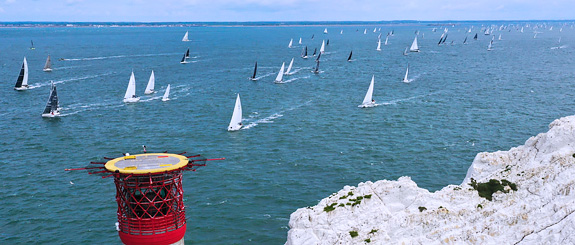This year’s Round the Island Race turned out to be a really thrilling and competitive event. 1100 boats entered the race, which took place on Saturday 1st July. The race started from the world famous Royal Yacht Squadron line in Cowes UK, with the largest and fastest boats starting first, leaving the rest of us to wait our turn.
The Round the Island Race is organised by the Island Sailing Club and is one of the biggest sailing events in the world. Spectators make their way to vantage points all around the island to watch the spectacular race, which attracts both the world’s top offshore sailors on their super yachts as well as more modest cruiser racers. There were a variety of classic yachts taking part this year including Sir Robin Knox-Johnston’s 32 foot ketch Suhaili, which he sailed around the world in 1969 in the first non-stop solo circumnavigation Golden Globe Race, which he won.
The course
The 50 nautical mile racecourse around the diamond shaped Isle of Wight begins in the Central Solent, then heads anti-clockwise down the Western Solent, passing the iconic Needles Lighthouse to port. The course then heads south of the island towards St Catherine’s point, the most southerly part of the Isle of Wight and from there heads northeast towards the Bembridge Ledge cardinal buoy. After leaving the Bembridge cardinal to port the fleet heads west into the Eastern Solent. From here it is usually a long beat back to Cowes for the finish in the prevailing southwesterly winds. This last leg takes you via No Man’s Fort and across Osborne Bay before reaching Cowes.
Are we competitive or out to have fun?
The massive fleet is subdivided into ten groups which start at 10 minute intervals between 0800 and 0930. My Contessa 26, Sulali is one of the smaller boats taking part and we were in the last group of more than 100 boats to leave. Knowing there were near enough 1000 boats ahead of us helped focus the mind, as Sulali’s crew relishes the challenge of slowly but surely overhauling the larger boats ahead. So are we competitive or just out to have fun? Well the answer to that is yes to both, we are happy to push ourselves and make every step count as we make our way round the course, but at the same time the atmosphere is electrifying, especially this year in the strong breeze and lively seas.
Challenging conditions south of the island
We had an excellent start, thanks to my friend Neil on helm who timed it perfectly. He positioned us so we would have a long starboard tack, giving us right of way over those on port tack, at the same time taking maximum advantage of the favourable tide which meant we were well clear of Egypt point before having to put in our first tack. We had a 12-15 knot breeze which was ideal and were soon overtaking larger boats which added to the fun. Neil’s wife Ros is an excellent sail trimmer and the three of us settled into a routine that enabled us to make very good progress towards the Needles.
The wind steadily strengthened over the next couple of hours and we saw gusts of over 20 knots before we reached the Needles. With her long, deep keel Sulali coped well with the gusty conditions, which can catch out lighter boats. The crew gets a drenching from the spray when sailing close hauled which was just about bearable given the time of year and circumstances.
After rounding the Needles, we had the wind behind us which meant we were on a much more comfortable point of sail for the next few hours, despite the quite considerable swell which kept us on our toes. Concentration was required to avoid accidental gybes and we were aware of several boats getting into difficulty because of the conditions.
The winner of the famous Golden Roman Bowl this year for the first boat overall was Christian Zugel’s Volvo 70 Tschuss 2, a brand new amazing racing machine. Added to this achievement Tschuss 2 also secured line honours, completing the race in 4 hours 11 minutes.
As for Sulali, a 45 year old Contessa 26, we finished 52nd overall, 18th in Group and 6th in ISC Division 8D. Our corrected time was 9 hours 01 minute which given the size of our little boat was fine by us.











